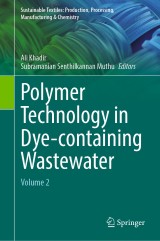Details

Polymer Technology in Dye-containing Wastewater
Volume 2Sustainable Textiles: Production, Processing, Manufacturing & Chemistry
|
85,59 € |
|
| Verlag: | Springer |
| Format: | |
| Veröffentl.: | 22.04.2022 |
| ISBN/EAN: | 9789811908866 |
| Sprache: | englisch |
Dieses eBook enthält ein Wasserzeichen.
Beschreibungen
The textile industry is among the most significant polluters of water owing to the existence of various types of pollution streams generated by printing processes and textile dyeing. The book begins by documenting various types of Poly (vinyl alcohol) PVA-derived adsorbents (gels, fibers, films, composite particles), membranes, and photocatalysts in combination with conventional adsorbents, polymers, carbonaceous and metallic materials and their use in elimination of dyes from contaminated water. It follows by discussing different properties of nanocomposite membranes such as hydrogels, xerogels and aerogels used in this purpose. Also, different polymer – based adsorbents such as ceramic adsorbent, clay, hydrogels, starch, cellulose, chitosan, alginates, etc are presented in this book.
Polymeric membranes nanocomposites as effective strategy for dye removal.- Poly(vinyl alcohol) (PVA)-based treatment technologies in the remediation of dye-containing textile wastewater.- Natural biodegradable polymeric bio-adsorbents for textile wastewater.- Polymer‐ Derived Ceramic Adsorbent For Removal of Dyes From Water.- Polymeric hydrogels for dye adsorption.- Dye Removal Using Polymer Composites as Adsorbents.- Bacterial Extracellular Polymeric Substances for Degradation of Textile Dyes.- Polymer Derived Electrospun Ceramic Nanofibers Adsorbents for Textile Waste Water Treatment.- Polymer Membrane in Textile Wastewater.- Applications of Inorganic Polymers in Textile Wastewater Treatment.
<p><b>Ali Khadir</b> is an environmental engineer and a member of the Young Researcher and Elite Club, Islamic Azad University of Shahre Rey Branch, Tehran, Iran. He has published several articles and book chapters in reputed international publishers, including Elsevier, Springer, Taylor & Francis, and Wiley. His articles have been published in journals with IF of greater than 4, including Journal of Environmental Chemical Engineering and International Journal of Biological Macromolecules. He also has been the reviewer of journals and international conferences. His research interests center on emerging pollutants, dyes, and pharmaceuticals in aquatic media, advanced water and wastewater remediation techniques and technology.</p>
<p><b>Dr. Subramanian Senthilkannan Muthu</b> currently works for SgT Group as Head of Sustainability, and is based out of Hong Kong. He earned his PhD from The Hong Kong Polytechnic University, and is a renowned expert in the areas of EnvironmentalSustainability in Textiles & Clothing Supply Chain, Product Life Cycle Assessment (LCA) and Product Carbon Footprint Assessment (PCF) in various industrial sectors. He has five years of industrial experience in textile manufacturing, research and development and textile testing and over a decade's of experience in life cycle assessment (LCA), carbon and ecological footprints assessment of various consumer products. He has published more than 100 research publications, written numerous book chapters and authored/edited over 100 books in the areas of Carbon Footprint, Recycling, Environmental Assessment and Environmental Sustainability.</p>
<p><b>Dr. Subramanian Senthilkannan Muthu</b> currently works for SgT Group as Head of Sustainability, and is based out of Hong Kong. He earned his PhD from The Hong Kong Polytechnic University, and is a renowned expert in the areas of EnvironmentalSustainability in Textiles & Clothing Supply Chain, Product Life Cycle Assessment (LCA) and Product Carbon Footprint Assessment (PCF) in various industrial sectors. He has five years of industrial experience in textile manufacturing, research and development and textile testing and over a decade's of experience in life cycle assessment (LCA), carbon and ecological footprints assessment of various consumer products. He has published more than 100 research publications, written numerous book chapters and authored/edited over 100 books in the areas of Carbon Footprint, Recycling, Environmental Assessment and Environmental Sustainability.</p>
The textile industry is among the most significant polluters of water owing to the existence of various types of pollution streams generated by printing processes and textile dyeing. The book begins by documenting various types of Poly (vinyl alcohol) PVA-derived adsorbents (gels, fibers, films, composite particles), membranes, and photocatalysts in combination with conventional adsorbents, polymers, carbonaceous and metallic materials and their use in elimination of dyes from contaminated water. It follows by discussing different properties of nanocomposite membranes such as hydrogels, xerogels and aerogels used in this purpose. Also, different polymer – based adsorbents such as ceramic adsorbent, clay, hydrogels, starch, cellulose, chitosan, alginates, etc are presented in this book.
Highlights the application of different polymers in dye-containing wastewater treatment Features the use of various membrane-based materials such as hydrogels, xerogels/aerogels, and ceramic adsorbent Includes adsorption, photocatalytic, and membrane technologies based on polymers
Diese Produkte könnten Sie auch interessieren:

Neutron Applications in Earth, Energy and Environmental Sciences

von: Liyuan Liang, Romano Rinaldi, Helmut Schober

149,79 €

Nanobioelectronics - for Electronics, Biology, and Medicine

von: Andreas Offenhäusser, Ross Rinaldi

96,29 €














